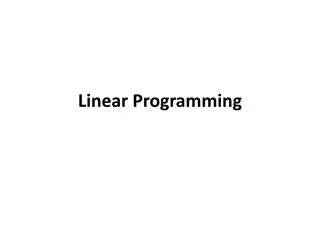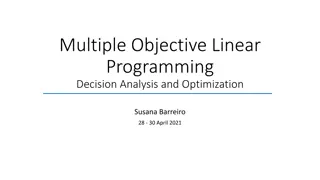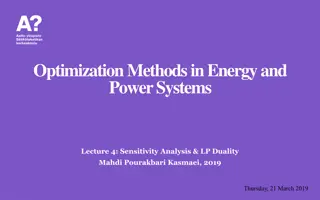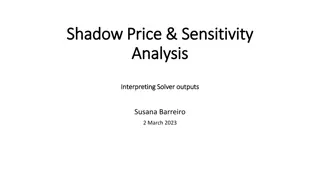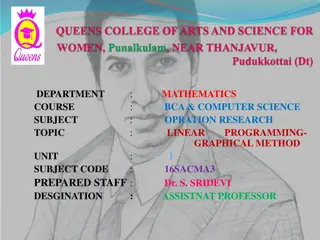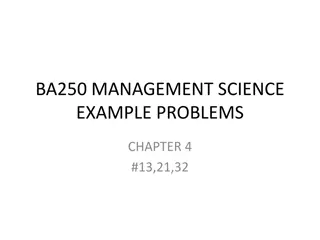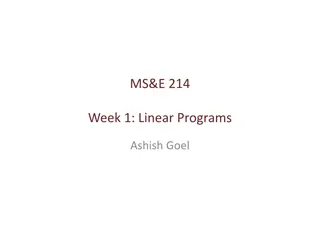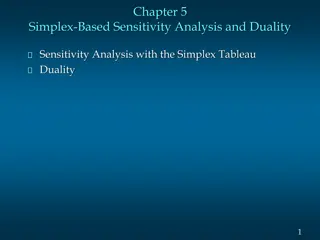Linear Programming and Sensitivity Analysis in Production Optimization
Explore the application of linear programming and sensitivity analysis in optimizing production processes using the example of RMC, Inc. Learn how to formulate and solve problems, maximize profits, and understand decision variables and constraints effectively.
Download Presentation

Please find below an Image/Link to download the presentation.
The content on the website is provided AS IS for your information and personal use only. It may not be sold, licensed, or shared on other websites without obtaining consent from the author.If you encounter any issues during the download, it is possible that the publisher has removed the file from their server.
You are allowed to download the files provided on this website for personal or commercial use, subject to the condition that they are used lawfully. All files are the property of their respective owners.
The content on the website is provided AS IS for your information and personal use only. It may not be sold, licensed, or shared on other websites without obtaining consent from the author.
E N D
Presentation Transcript
Welcome to BUS-660 Quantitative Methods @dralexcasteel Dr. Alex Casteel alex.casteel@gcu.edu (480) 694-0662 @alexcasteel
Administration TOPIC Participation in DQs & Class Homework
Introduction to Linear Programming and Sensitivity Analysis What is it? Using a set of known constraints to reach an optimal outcome
RMC, Inc., is a small firm that produces a variety of chemical-based products. In a particular production process, three raw materials are used to produce two products: a fuel additive and a solvent base. The fuel additive is sold to oil companies and is used in the production of gasoline and related fuels. The solvent base is sold to a variety of chemical firms and is used in both home and industrial cleaning products. The three raw materials are blended to form the fuel additive and solvent base. One ton of fuel additive is a mixture of 0.4 tons of material 1 and 0.6 tons of material 3. A ton of solvent base is a mixture of 0.5 tons of material 1, 0.2 tons of material 2, and 0.3 tons of material 3. Maximize the profit if there is a profit contribution of $40 for every ton of fuel additive produced and $30 for every ton of solvent base produced. Example
Linear Programming & Sensitivity Analysis PROBLEM FORMULATION GRAPHICAL APPROACHES SOLVER-BASED SOLUTIONS SENSITIVITY ANALYSIS
Problem Formulation Identifying the desired outcome of the problem and understanding and using all the problem boundaries to arrive at the correct solution
1. Understand the problem thoroughly 2. Describe each objective 3. Describe each constraint 4. Define the decision variables 5. Write the objective in terms of the decision variables 6. Write the constraints in terms of the decision variables 7. Add the negativity constraints Problem Formulation
1. Understand the problem thoroughly Read through the problem Read through the problem again Visualize the scenario as if you were the manager Problem Formulation
2. Describe each objective The objective is typically to maximize or minimize a function, such as maximizing profits or minimizing costs Problem Formulation
3. Describe each constraint Constraints are the boundaries or requirements placed upon the analysis by availability of resources, product or service requirements, desired outcomes, or other restrictions placed upon the system. Problem Formulation
Problem Formulation 4. Define the decision variables The decision variables are the controllable inputs for the problem
5. Write the objective in terms of the decision variables The objective is the desired outcome and is developed as a function of the decision variables (see step 4) Problem Formulation If you are struggling to identify the decision variables, begin writing your best guess of the objective function. The decision variables will tend to identify themselves as you do this.
6. Write the constraints in terms of the decision variables Express the constraint identified in step 3 in terms of the decision variables identified in step 4. Constraints are expressed as mathematical statements. Problem Formulation
Problem Formulation 7. Add the negativity constraints Because most decision variables may not be a negative value, these constraints must be identified.
1. Understand the problem thoroughly 2. Describe each objective 3. Describe each constraint 4. Define the decision variables 5. Write the objective in terms of the decision variables 6. Write the constraints in terms of the decision variables 7. Add the negativity constraints Problem Formulation
Example Step 1 Understand the problem
Example Step 2 Describe the objective Maximize profits based upon profit contributions of $40/ton for fuel additive and $30/ton for solvent base.
1. The number of tons of material 1 used must be less than or equal to the 20 tons available. 2. The number of tons of material 2 used must be less than or equal to 5 tons available 3. The number of tons of material 3 used must be less than or equal to 21 tons available Example Step 3 Describe each constraint
Example Step 4 Define the decision variables F = number of tons of fuel additive S = number of tons of solvent base
Example Step 5 Write the objective in terms of the decision variables Total profit contribution = 40F + 30S
1. The number of tons of material 1 used must be less than or equal to the 20 tons available. Tons of material 1 used Tons of material 1 available Tons of material 1 used = 0.4F + 0.5S Example 0.4F + 0.5S 20 Step 6 Write the constraints in terms of the decision variables Exercise: Write constraints 2 and 3
2. The number of tons of material 2 used must be less than or equal to the 5 tons available. Tons of material 2 used Tons of material 2 available Tons of material 2 used = 0.2S Example 0.2S 5 Step 6 Write the constraints in terms of the decision variables Exercise: Write constraints 2 and 3
3. The number of tons of material 3 used must be less than or equal to the 21 tons available. Tons of material 3 used Tons of material 3 available Tons of material 3 used = 0.6F + 0.3S Example 0.6F + 0.3S 21 Step 6 Write the constraints in terms of the decision variables Exercise: Write constraints 2 and 3
RMC cannot produce a negative amount of fuel additive (F) or solvent base (S); therefore, F 0 and S 0 Example F, S 0 Step 7 Add non- negativity constraints
Max 40F + 30S Example Subject to (s.t.) 0.4F + 0.5S 20 Material 1 0.2S 5 Material 2 0.6F + 0.3S 21 Material 3 F, S 0 Mathematical model
Are we done? Now it is time to find the optimal solution!
By graphing the constraints and then testing the critical points, one may determine the optimal solution Graphical solution procedure for maximization problems 1. Prepare a graph for each constraint that shows the solutions that satisfy the constraint. 2. Determine the feasible region by identifying the solutions that satisfy all the constraints simultaneously. 3. Draw an objective function line showing the values of the decision variable that yield a specified value of the objective function. 4. Move parallel objective function lines toward larger objective function values until further movement would take the line completely outside the feasible region. 5. Any feasible solution on the objective function line with the largest value is an optimal solution. Graphical Approaches
Graphical Approaches Material 1 Constraint line Begin to define feasibility region Feasibility Region
Graphical Approaches Material 1 Constraint line Material 2 Constraint line Material 3 Constraint line Feasibility region is defined by the constraints and includes all possible outcomes
Graphical Approaches Plot the Maximum Profit Line Max 40F + 30S Max 40F + 30S
Graphical Approaches Plot the Maximum Profit Line The intersection will occur at one of five extreme points
Solver-based Solutions RMC Fuel Additive Solvent Base Amount to produce 25 20 Material Requirements Constraints Material Material 1 Material 2 Material 3 Profit Per Ton Fuel Additive Solvent Base Used Available 0.4 0.5 0.2 0.3 30 20 4 21 20 5 21 0 0.6 40 Objective Maximize Total 40 30 1600 Module 3.Class Examples.xlsx
Minimization Solutions Describe the objective Module 3.Class Examples.xlsx > M&D Chemicals
Sensitivity analyses allow one to determine how much a single Objective Function Coefficient may change without changing the Optimal Solution Sensitivity Analysis
Sensitivity Analysis Objective coefficients of 40 for F and 30 for S lead to a solution of 25 tons of F and 20 tons of S. Should the profitability of one coefficient change (let s use F), does the optimal solution of F = 25 and S = 20 change? objective coefficient to maintain the optimal solution for maximum profit? What is the allowable range for the S Objective coefficient 40 + 20 max or 40 16 (min) requires no change to the optimal solution. Therefore, provided 24 F 60, then F = 25, S = 20 will still maximize profits. 20 S 50
Linear Programming & Sensitivity Analysis PROBLEM FORMULATION GRAPHICAL APPROACHES SOLVER-BASED SOLUTIONS SENSITIVITY ANALYSIS
Additional Resources Complete summary, including graphical solution, solver, and sensitivity analysis https://youtu.be/m1OAo7W1FIk Linear Programming (LP) Sensitivity Analysis Interpreting Excel s Solver Report https://youtu.be/FzY333RdrBM
Looking Ahead Topic 3 DQ 1 Topic 3 DQ 2 Topic 3 Homework Linear Programming: Applications in Marketing, Finance, and Operations Management Midterm exam
Dr. Alex Casteel alex.casteel@gcu.edu (480) 694-0662 (text or call) Halo Messaging







